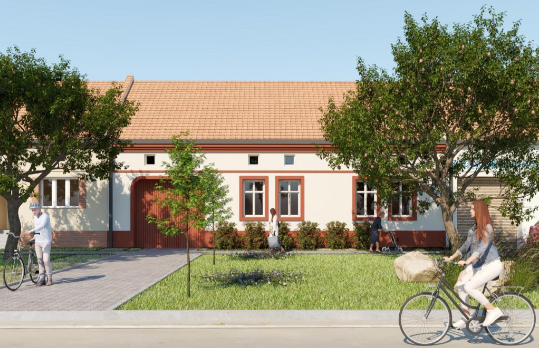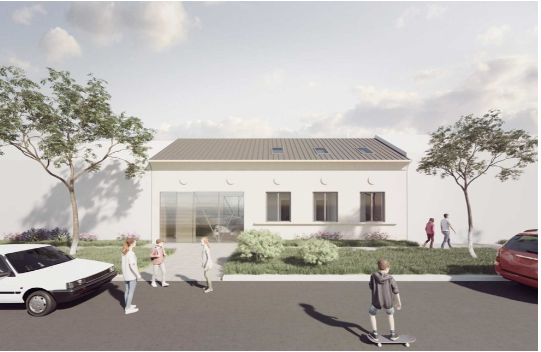Ideas and discoveries
Thanks to the house for Slovakia, people received quick architectonic help after the tornado

Czech architects also lent a helping hand after the devastating tornado in Moravia in 2021. A graduate of the BUT Faculty of Architecture and founder of YUAR architects, Lukáš Janáč approached colleagues in the field and created three variations on a typical Slovakian house. On the website of the Obnova 21 project, interested parties could then download free architectural studies. Thanks to this initiative, several new houses are already standing, others are still under construction. And Lukáš Janáč became the head of the pro bono working group at the Czech Chamber of Architects.
When a tornado swept through South Moravia at the end of June 2021, a number of villages around Hodonín were devastated within a few minutes. Architect Lukáš Janáč, who comes from the area, then, like most of the people, thought about how to help the local people. "There was a big wave of solidarity, which was great. My first thought was of course to send money. But a lot of money went to those people. There were also a lot of volunteers willing to clean and help. What was missing were authorized persons," Janáč says, who went to see the place a few days after the disaster.
A number of houses became uninhabitable after the tornado, and the structural engineers immediately decided to demolish them. "Houses suddenly had to be quickly demolished, permitted, built. And it turned out that the state is not prepared for such situations and cannot react flexibly enough. However, everyone tried their best on the spot. For example, we were in contact with the Hodonín building authority, and they handled it very well," he recalls.
A number of people thus found themselves in a situation where their houses, in which they had often spent their entire lives, had to be razed to the ground. "It was clear that it would be necessary to build. And I, as an authorized person, felt that this is where I can best help," the graduate of the Faculty of Architecture at BUT and the founder of YUAR architects adds. In addition, according to his words, it occurred to him that after experiencing a shock, people need to focus on something definite and push out the horror that happened to them.
HE WAS NOT ENOUGH TO HELP BY HIMSELF, THAT'S WHY OBNOVA 21 WAS ESTABLISHED
The information about his consulting services spread very quickly among people. "Suddenly I was in a situation where I had to say no, because it was clear to me that I couldn't please everyone. It was therefore necessary to figure out how I could deliver help to as many people as possible," Janáč describes. He therefore teamed up with architects Ivan Boroš from the Edit studio, Jakub Děng from Desk architekti and Marc Maio from Maio architects and head of the studio at the Department of Architecture of the Faculty of Civil Engineering of the Czech Technical University in Prague. "A lot of similar houses fell down. It's a typical L-shaped country house. That's why we thought, let's try to design it three different times. We then called it the House for Slovakia," Janáč explains.
The architects had to preserve the original floor plan. Especially so that people can draw a subsidy for the construction. "The condition of the subsidy was that it had to be a renovation according to the Building Act. So, the new house had to be more or less the same as the original one. This caused a number of problems. When someone had a big house and it fell down, he had to build a big house again. But he probably didn't have the money for that. Or the original house didn't suit him, because it was a hundred years old, and now he had to build an equally unsuitable house again," Lukáš Janáč points out the complexity of restoring damaged villages.
That is why the architects agreed that their house must be suitable for today's times, preserve the character of the village, enhance the public space and be comfortable inside. "Although we defined the assignment relatively quickly, it turned out that we are not well prepared to help either. We needed to make a website and figure out how to deliver the proposal to interested parties. So that it can't be misused at first. To transfer the copyright to the interested parties. At the same time, it is a professional service, so we had to somehow guarantee it and the like," Janáč enumerates. In the end, they managed to make all the documents available to people in two months.
They provided their services and advice to approximately fifteen people. "Which is about ten percent of those whose houses were affected and had to deal with new construction," Janáč says. The project is currently running out of steam. "Overall, we discovered something that could continue to work in the future, and above all, faster and better. We know how it should be next time. And it would be great if someone continued with it," Lukáš Janáč notes, adding that if there was, for example, an architecture student who would be interested in it, they would very much welcome it.
WHERE HELP ENDS AND UNFAIR COMPETITION BEGINS
At the same time, the Obnova 21 initiative also inspired the Czech Chamber of Architects. "I have to praise the chamber, actually us, because it reacted excellently. A pro bono working group was established within the chamber. I went to the board of directors and reported on what I saw and experienced in the affected villages," Janáč says, who eventually became the head of this working group.
Now the rules of pro bono service are emerging within the group. "We define what it is and what it is no longer, what everything is connected with pro bono help. We found out that it is nice to help, but everything has its own rules. When a natural person's house is blown down by a storm, it is appropriate to help pro bono, i.e. immediately and at a reduced price or, even better, for free. But when the same gale blows down municipal property, it is impossible to provide the services of an architect or designer at a reduced price, that would be on the verge of unfair competition. It is correct to proceed according to the law on the awarding of public contracts," Lukáš Janáč points out, adding that the goal is to prepare rules and a platform for aid so that it can be used immediately in the event of a similar disaster. "In the Czech Republic, we have floods, fires, and storms. So, another similar natural disaster can come unexpectedly at any time. Our main goal is to offer a pre-prepared package to thousands of other authorized persons who want and can help, but don't know how or don't have the experience," he explains. According to him, pro bono assistance is a topic that makes sense to develop in the long term. "It's also a question of our professional responsibility and trying to give something back to society," he concludes.
The interior of the church should be the opposite of the outside world, architect Marek Štěpán says
We hit mark with the dot, says the founder of the fashion brand VUCH
Roman Bolcek from FA BUT presents a BIOM vision of future cities in a book. Nothing terrible awaits us, he thinks
Women from BUT who move the world of science and technology
The Czech Republic of the future. Young architects presented more than a hundred unconventional ideas
